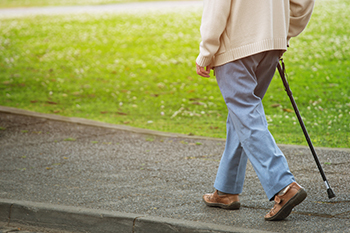Items filtered by date: June 2023
Toe Pain May Be Caused by Arthritis

Toe pain may be caused by arthritis. This condition targets the joints in the body, and the toes are no exception. Toe arthritis generally affects the big toe, and can happen as a result of having endured a previous injury. These can include a broken toe, sprained toe, or gout, which is a different form of arthritis. Toe pain from arthritis may also happen from being overweight, or if family members have had arthritis. Patients describe the pain from toe arthritis as ranging from an achy feeling to a stabbing sensation when movement of the toe is attempted. The symptoms that can accompany toe arthritis can consist of swelling, a change in appearance, or there may be clicking and popping noises. Treatment may depend on the severity of the pain and how often it occurs. If you have toe pain, it is strongly suggested that you speak with a podiatrist who can determine what the reason is, and treat it accordingly.
Toe pain can disrupt your daily activities. If you have any concerns, contact Darren Day, DPM of Hawaii. Our doctor can provide the care you need to keep you pain-free and on your feet.
What Causes Toe Pain?
Most severe toe pain is caused due to a sports injury, trauma from dropping something heavy on the toe, or bumping into something rigid. Other problems can develop over time for various reasons.
Toe pain can be caused by one or more ailments. The most common include:
- Trauma
- Sports injury
- Wearing shoes that are too tight
- Arthritis
- Gout
- Corns and calluses
- Hammertoe
- Bunions
- Blisters
- Ingrown toenails
- Sprains
- Fractures (broken bones)
- Dislocations
When to See a Podiatrist
- Severe pain
- Persistent pain that lasts more than a week
- Signs of infection
- Continued swelling
- Pain that prevents walking
Diagnosis
In many cases the cause of toe pain is obvious, but in others, a podiatrist may want to use more advanced methods to determine the problem. These can range from simple visual inspections and sensation tests to X-rays and MRI scans. Prior medical history, family medical history, and any recent physical traumatic events will all be taken into consideration for a proper diagnosis.
Treatment
Treatments for toe pain and injuries vary and may include shoe inserts, padding, taping, medicines, injections, and in some cases, surgery. If you believe that you have broken a toe, please see a podiatrist as soon as possible.
If you have any questions please feel free to contact our offices located in Honolulu and Kahuku, HI . We offer the newest diagnostic tools and technology to treat your foot and ankle needs.
Unsightly Cracked Heels

Having cracked heels is a foot condition that can cause embarrassment. It is defined as cracks that develop in the skin of the heels and may become fissures if conservative treatment does not work. Cracked heels can happen for a variety of reasons, including wearing shoes that have an open back, or standing on hard surfaces for the majority of the day. Additionally, frequently wearing flip-flops may lead to developing cracked heels, as a result of the lack of support most of these types of shoes have. Elderly people may notice they have cracked heels. The heel pads can lose elasticity, possibly causing cracked heels. People who are overweight may also be prone to getting cracked heels, which can be from the extra weight the heels must endure. Relief may be found when the feet are soaked in warm water, followed by applying a good moisturizer on them. If you have cracked heels, it is strongly suggested that you are under the care of a podiatrist who can offer you effective prevention and relief methods.
Cracked heels are unsightly and can cause further damage to your shoes and feet. If you have any concerns, contact Darren Day, DPM from Hawaii. Our doctor can provide the care you need to keep you pain-free and on your feet.
Cracked Heels
Cracked heels appear unappealing and can make it harder for you walk around in sandals. Aside from looking unpleasant, cracked heels can also tear stockings, socks, and wear out your shoes. There are several methods to help restore a cracked heel and prevent further damage.
How Do You Get Them?
Dry skin is the number one culprit in creating cracked heels. Many athletes, walkers, joggers, and even swimmers suffer from cracked heels. Age and skin oil production play a role to getting cracked heels as well.
Promote Healing
Over the counter medicines can help, especially for those that need instant relief or who suffer from chronic dry feet.
Wear Socks – Wearing socks with medicated creams helps lock in moisture.
Moisturizers – Applying both day and night will help alleviate dryness which causes cracking.
Pumice Stones – These exfoliate and remove dead skin, which allows for smoother moisturizer application and better absorption into the skin.
Change in Diet
Eating healthy with a well-balanced diet will give the skin a fresh and radiant look. Your body responds to the kinds of food you ingest. Omega-3 fatty acids and zinc supplements can also revitalize skin tissue.
Most importantly, seek professional help if unsure how to proceed in treating cracked heels. A podiatrist will help you with any questions or information needed.
If you have any questions, please feel free to contact our offices located in Honolulu and Kahuku, HI . We offer the newest diagnostic and treatment technologies for all your foot care needs.
Gently Exercising May Help to Prevent Falling

People who are 65 years old or older have increased chances of incurring a fall. A common reason this can happen may be a result of decreasing body strength as aging happens. A good fall prevention technique can include implementing a gentle exercise routine that can increase cardiovascular and muscle strength. Falling can have serious consequences, and may affect the feet. A broken ankle or toe may cause pain and difficulty in completing daily activities. Research has shown there are several thousand seniors who live independently, and many falls can occur in the home. Fall prevention strategies can include removing worn rugs from the living area, and it is helpful to improve lighting in the main areas of the household. Many people choose to have grab bars installed in the shower and toilet area, and it is beneficial to use a non-slip bath mat. If you would like to have additional knowledge about effective fall prevention techniques, it is suggested that you consult with a podiatrist who can help you with methods that can protect the feet.
Preventing falls among the elderly is very important. If you are older and have fallen or fear that you are prone to falling, consult with Darren Day, DPM from Hawaii. Our doctor will assess your condition and provide you with quality advice and care.
Every 11 seconds, an elderly American is being treated in an emergency room for a fall related injury. Falls are the leading cause of head and hip injuries for those 65 and older. Due to decreases in strength, balance, senses, and lack of awareness, elderly persons are very susceptible to falling. Thankfully, there are a number of things older persons can do to prevent falls.
How to Prevent Falls
Some effective methods that older persons can do to prevent falls include:
- Enrolling in strength and balance exercise program to increase balance and strength
- Periodically having your sight and hearing checked
- Discuss any medications you have with a doctor to see if it increases the risk of falling
- Clearing the house of falling hazards and installing devices like grab bars and railings
- Utilizing a walker or cane
- Wearing shoes that provide good support and cushioning
- Talking to family members about falling and increasing awareness
Falling can be a traumatic and embarrassing experience for elderly persons; this can make them less willing to leave the house, and less willing to talk to someone about their fears of falling. Doing such things, however, will increase the likelihood of tripping or losing one’s balance. Knowing the causes of falling and how to prevent them is the best way to mitigate the risk of serious injury.
If you have any questions, please feel free to contact our offices located in Honolulu and Kahuku, HI . We offer the newest diagnostic and treatment technologies for all your foot care needs.
Keep Your Feet Healthy So You Can Stay Active
Signs of Athlete's Foot

The top layer of the skin is affected when athlete’s foot develops. It can cause severe itching and redness, and the area may become dry and begin to flake. It is considered to be contagious, and the fungus that causes this ailment lives in warm and moist environments. These can include shower room floors, public swimming pools, and surrounding areas. An effective preventive method can consist of wearing appropriate shoes while in these types of places, such as flip-flops or water shoes. Patients who have athlete’s foot may also find they have cracked heels, and applying a good moisturizer may help them to find mild relief. In severe cases of athletes’ foot, small blisters may begin to form and ooze. This may also be managed by using moisturizer. Many patients who have developed athlete’s foot often seek the advice of a podiatrist, and it is suggested that you contact this type of doctor who can prescribe medication as an effective treatment method.
Athlete’s foot is an inconvenient condition that can be easily reduced with the proper treatment. If you have any concerns about your feet and ankles, contact Darren Day, DPM from Hawaii. Our doctor will treat your foot and ankle needs.
Athlete’s Foot: The Sole Story
Athlete's foot, also known as tinea pedis, can be an extremely contagious foot infection. It is commonly contracted in public changing areas and bathrooms, dormitory style living quarters, around locker rooms and public swimming pools, or anywhere your feet often come into contact with other people.
Solutions to Combat Athlete’s Foot
- Hydrate your feet by using lotion
- Exfoliate
- Buff off nails
- Use of anti-fungal products
- Examine your feet and visit your doctor if any suspicious blisters or cuts develop
Athlete’s foot can cause many irritating symptoms such as dry and flaking skin, itching, and redness. Some more severe symptoms can include bleeding and cracked skin, intense itching and burning, and even pain when walking. In the worst cases, Athlete’s foot can cause blistering as well. Speak to your podiatrist for a better understanding of the different causes of Athlete’s foot, as well as help in determining which treatment options are best for you.
If you have any questions please feel free to contact our offices located in Honolulu and Kahuku, HI . We offer the newest diagnostic and treatment technologies for all your foot and ankle needs.






